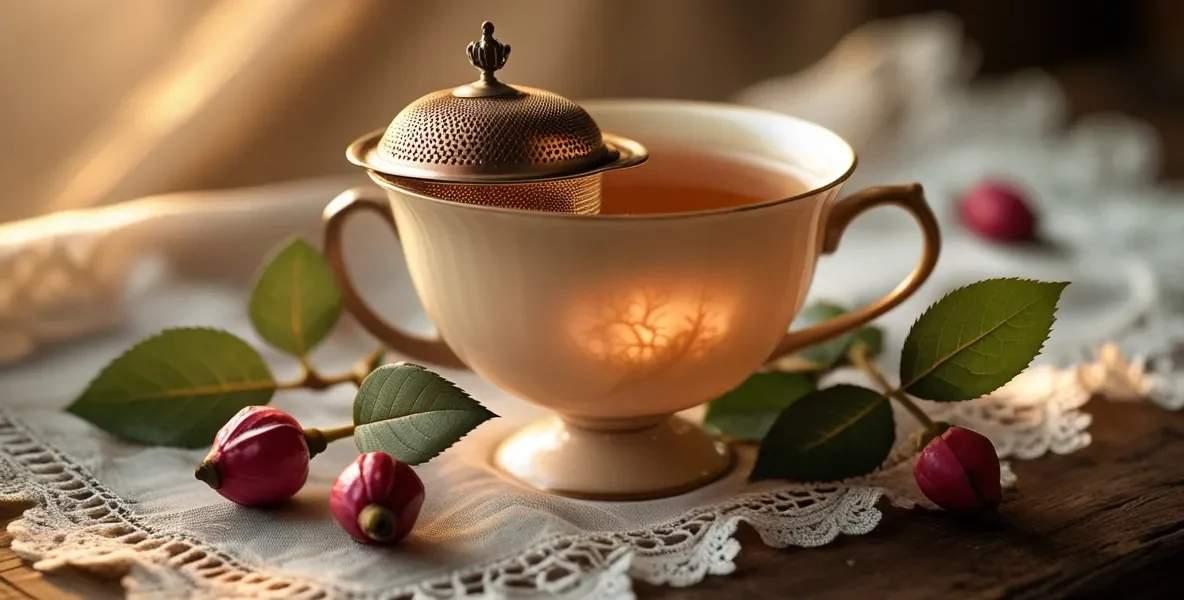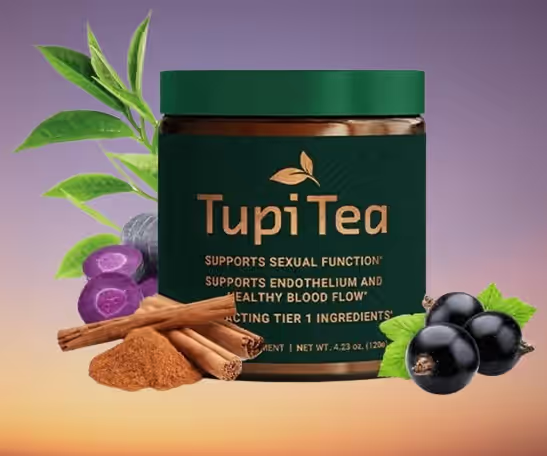Table of Contents
So, you’re looking for new ways to enjoy your tea, huh? Well, if you haven’t tried rosehip tea yet, you’re in for a treat. It’s got this nice, slightly tart taste, and it’s also pretty good for you. People have been drinking it for ages, and it’s super easy to make. Whether you’re using dried rosehips or fresh ones from your garden, getting a delicious cup of this stuff is simple. Today, we’re going to check out ten different ways to make your rosehip tea even better, adding all sorts of flavors to your regular recipe for rosehip tea.
Key Takeaways
- Rosehip tea is made from the fruit of rose plants and has a unique sweet and tart flavor.
- You can easily make rosehip tea from dried or fresh rosehips.
- Rosehip tea is known for its good-for-you properties and has been used for a long time in different cultures.
- There are many ways to change up your rosehip tea, like adding honey, mint, or other fruits.
- Making your own rosehip tea at home is a simple process, whether you pick them yourself or buy them ready to go.
1. Honey
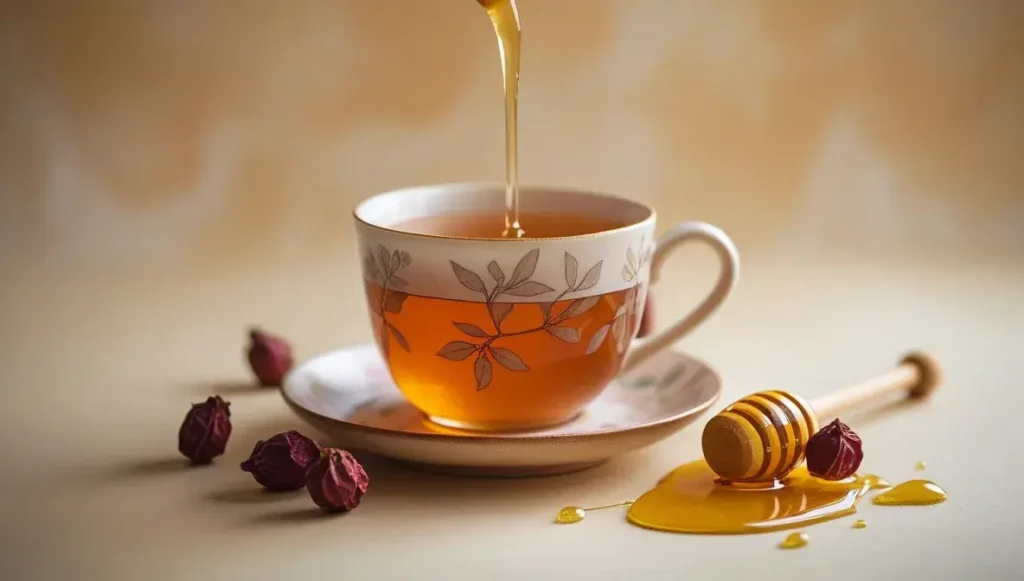
Okay, so you’ve got your rosehip tea brewed, and it’s… well, it’s a bit tart, right? That’s where honey comes in. Forget the sugar; honey not only sweetens your tea but also brings its own set of good stuff to the party.
I’ve been experimenting with different kinds of honey lately, and it’s amazing how much the flavor changes depending on the variety. A darker, more robust honey, like buckwheat, will give your tea a deeper, almost molasses-like note. On the other hand, a lighter honey, like clover, will just add a touch of sweetness without overpowering the rosehip flavor.
Here’s a simple way to do it:
- Brew your rosehip tea as usual.
- Let it cool slightly – you don’t want to destroy all the good enzymes in the honey with boiling water.
- Add a teaspoon of honey, stir, and taste.
- Adjust to your liking. Some days I want it sweeter, some days I don’t.
I’ve also been playing around with infused honeys. Lavender honey in rosehip tea? Surprisingly delicious. Cinnamon honey? Adds a nice warmth, especially on a cold day. Don’t be afraid to get creative!
And if you’re feeling adventurous, you could even try making a rosehip oxymel. It’s an old-school remedy that uses honey and vinegar to extract the goodness from herbs. I tried it last month, and it was surprisingly good. It’s a bit more involved than just stirring honey into your tea, but it’s worth a shot if you’re into that kind of thing.
2. Mint
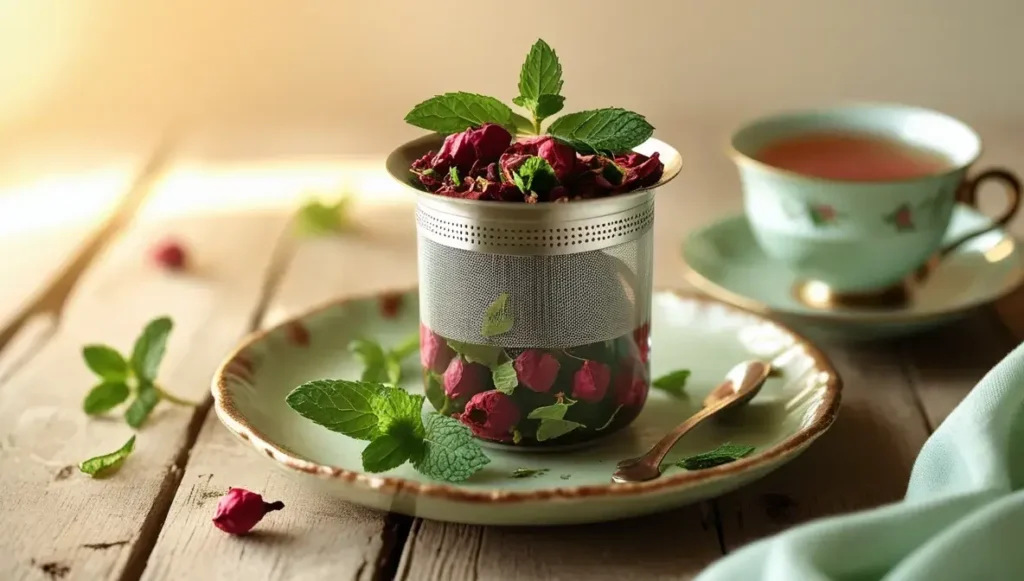
Rosehip tea has a slightly tart flavor, which some people find a bit too intense. That’s where mint comes in! Adding mint not only mellows out the tartness but also introduces a refreshing coolness that’s perfect for any time of year. I’ve found it’s especially nice on a hot summer day when you want something hydrating and flavorful.
It’s super easy to do. Just toss in a few fresh mint leaves while the rosehips are steeping. I usually use around 5-6 leaves for a standard-sized teapot, but you can adjust it to your liking. Experiment with different types of mint too! Spearmint is a classic choice, but peppermint can add a bit of a zing. Chocolate mint? Now that’s a fun twist!
I like to crush the mint leaves slightly before adding them to the tea. It helps release more of their essential oils, making the flavor even more pronounced. Plus, the aroma is just amazing!
👉 Grab the Premium Rosehip Tea Experience You Deserve Now 👈
3. Hibiscus
Hibiscus and rosehip? Oh yeah, that’s a good combo. The tartness of rosehip really plays well with the floral notes of hibiscus. It’s like a party in your mouth, but a healthy party, you know?
Here’s a simple way to make it:
- Grab 2 tablespoons of dried hibiscus petals.
- Add 1 tablespoon of dried rosehip shells.
- Toss in a cinnamon stick (optional, but recommended).
- Boil 4 cups of water.
- Simmer everything together for about 10-15 minutes, then let it steep for another 5. Strain, sweeten if you want, and enjoy!
I’ve been making this tea for a while now, and I swear it helps with my digestion. Plus, all those antioxidants are supposed to be good for you, right? I usually drink it hot, but it’s also pretty refreshing over ice on a hot day.
It’s a pretty simple recipe, but the flavor is anything but boring. The hibiscus adds a beautiful color and a slightly sweet taste that balances the rosehip perfectly.
4. Green Apple
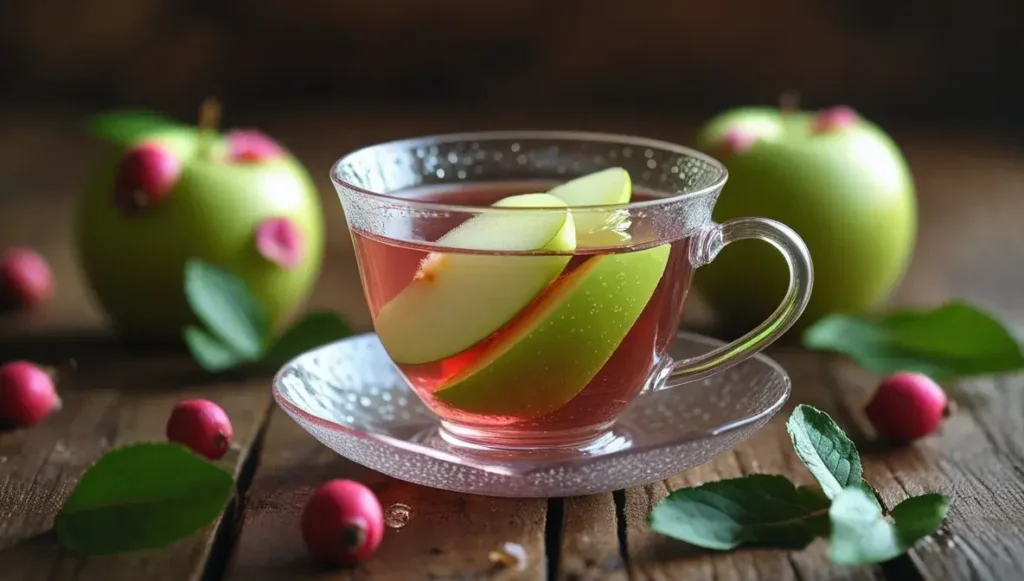
Okay, so you’ve got your rosehip tea, right? Now, imagine adding a crisp, slightly tart green apple to the mix. It’s surprisingly good! The natural sweetness of the apple balances out the rosehip’s tanginess in a way that’s just…chef’s kiss.
I tried this last week when I was trying to use up some apples that were about to go bad, and now I’m hooked. It’s like a healthy, fruity explosion in your mouth. Plus, it makes the tea look all fancy and stuff.
Here’s how I usually do it:
- Brew your rosehip tea as usual.
- While it’s steeping, chop up about half of a green apple into small pieces.
- Add the apple pieces to the tea while it’s still hot.
- Let it steep for another 5-10 minutes to really let the apple flavor infuse.
You can also add a cinnamon stick for extra warmth and spice. It’s especially nice during the colder months. Trust me, it’s a game changer.
I’ve also tried grating the apple instead of chopping it. It makes the apple flavor more intense, but it can also make the tea a bit cloudy. So, it’s really up to you and your preferences.
The green apple really elevates the rosehip tea. It’s a simple addition, but it makes a world of difference.
👉 Discover the Best Organic Rosehip Tea for Your Wellness 👈
5. Ripe Plum
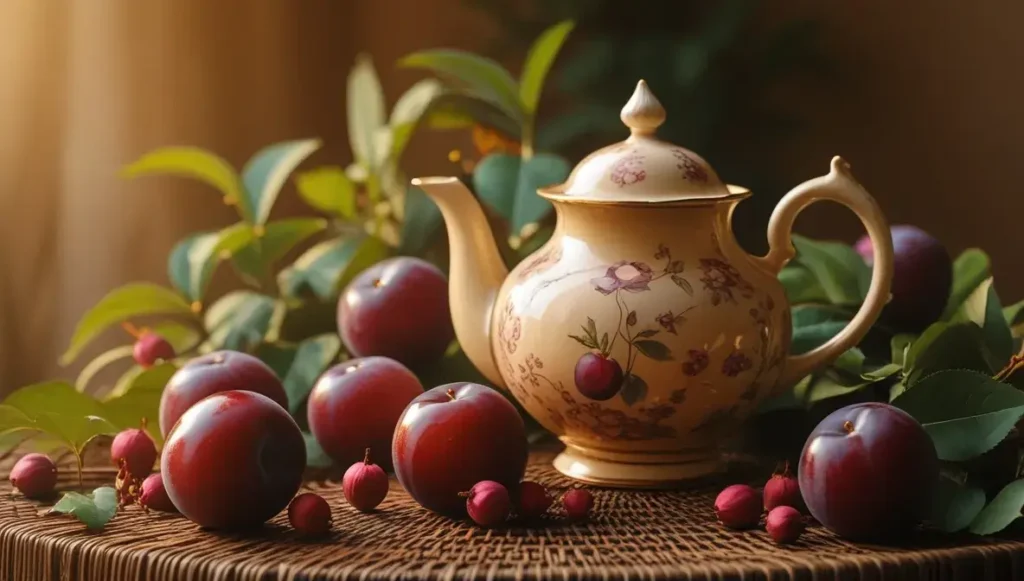
Rosehip tea has a naturally tart flavor, so adding ripe plum can really balance it out with some sweetness and depth. I tried this last week, and it was surprisingly good! The plum makes the tea feel a bit more substantial, almost like a light dessert.
To make this variation, you’ll need:
- 2 cups of water
- 1/2 cup of dried rosehips
- 1 ripe plum, pitted and sliced
- Honey or maple syrup to taste (optional)
Instructions:
- Combine water and rosehips in a saucepan.
- Bring to a boil, then reduce heat and simmer for 15-20 minutes.
- Add the sliced plum and simmer for another 5 minutes.
- Strain the tea into a mug and sweeten if desired.
The plum not only adds sweetness but also a subtle fruity aroma that complements the rosehip’s tartness. It’s a great way to use up plums that are just a little too ripe to eat on their own.
I found that using a really ripe plum made the tea a bit sweeter, so I didn’t need to add any extra sweetener. Experiment with different types of plums to see which flavor you like best!
6. Rose Petals
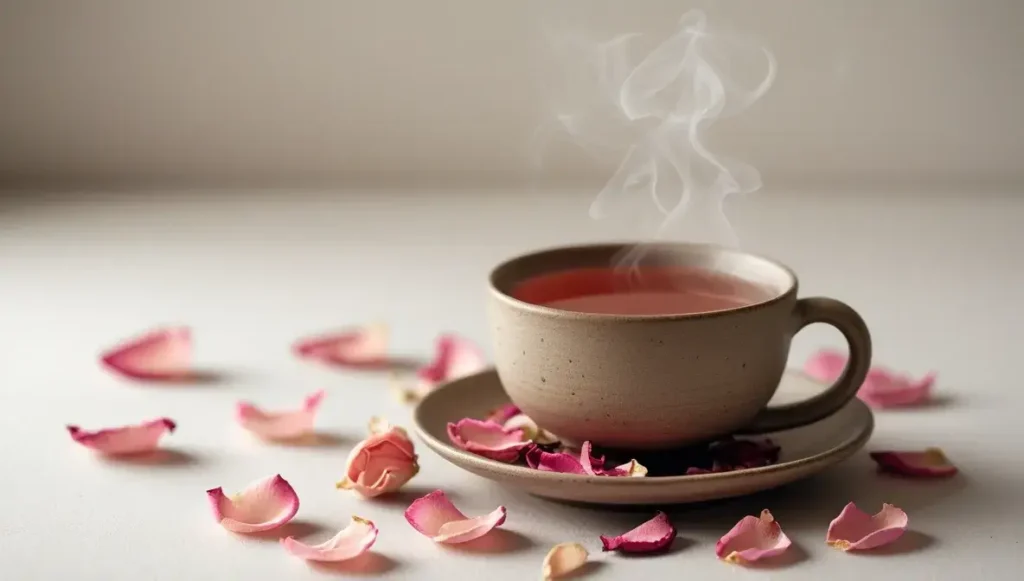
Okay, so you’re already making rosehip tea, why not double down on the rose flavor? Adding rose petals to your rosehip tea is a simple way to intensify the floral notes and create a really aromatic and soothing drink. It’s like taking your tea experience to the next level.
Here’s the thing, though: not all roses are created equal. You want to make sure you’re using petals from roses that haven’t been sprayed with pesticides or other chemicals. Organic is definitely the way to go here. You can either grow your own (if you’re lucky enough to have a garden) or buy dried, food-grade rose petals. I usually get mine from a local herb shop, but you can find them online too.
Here’s a simple way to do it:
- Brew your rosehip tea as usual.
- Add a teaspoon or two of dried rose petals to your cup.
- Let it steep for another 5-10 minutes.
- Strain and enjoy!
The key is to experiment with the amount of rose petals you use. Some people like a really strong rose flavor, while others prefer something more subtle. Start with a small amount and add more to taste. Also, consider the type of rose you’re using. Different varieties have different flavors, so you might need to adjust the amount accordingly.
It’s a great way to add a touch of elegance to your daily tea ritual. Plus, it just feels fancy, you know?
👉 Try Our Top‑Rated Rosehip Tea Blend Today and Save 👈
7. Rosehip Jam
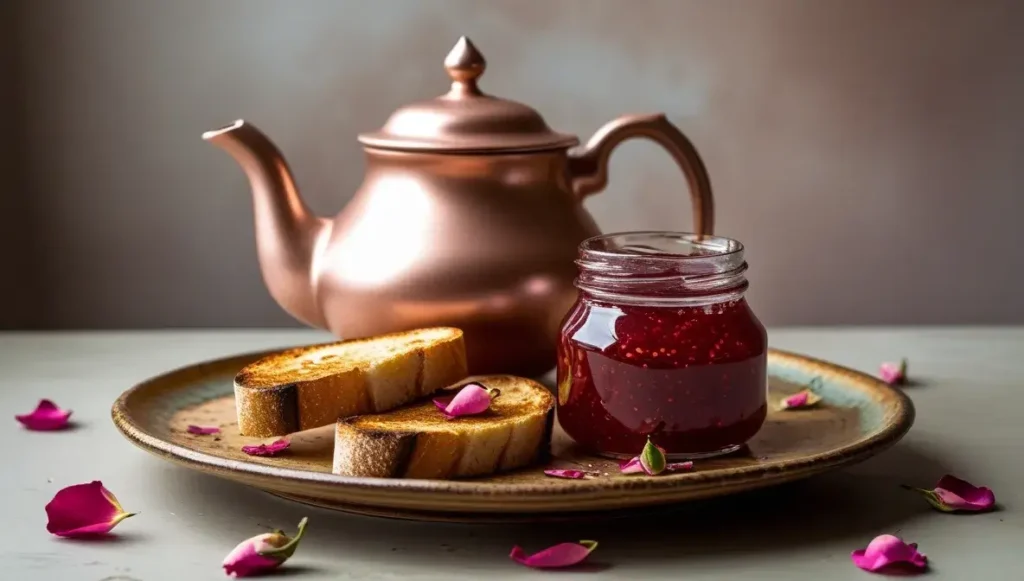
If you’re looking for easy rosehip tea ideas beyond just a drink, rosehip jam is a fantastic option. It’s a great way to preserve the rosehips and enjoy their flavor throughout the year. Plus, it’s surprisingly easy to make!
Rosehip jam is full of antioxidants and tastes amazing on toast or paired with cheese.
Making jam is one of the best rosehip drink recipes. It’s a simple way to use rosehips, and the result is a delicious spread that captures the essence of the rosehip flavor. You can find many rosehip tea recipes online, but here’s a basic idea to get you started:
- Gather your rosehips. You’ll need a good amount, as they shrink down during cooking.
- Clean and prepare the rosehips. This involves removing the stems and blossom ends, and carefully scooping out the seeds and irritating hairs inside.
- Cook the rosehips with water until they are soft. Then, mash them up.
- Strain the mixture to remove any remaining seeds or hairs.
- Add sugar and cook until the jam reaches the desired consistency.
Rosehip jam is a delightful way to enjoy the benefits of rosehips in a different form. It’s a bit of work to prepare the rosehips, but the end result is well worth the effort. It’s a great addition to your pantry and a unique way to experience the flavor of rosehips.
Consider experimenting with different homemade rosehip tea blends by adding other fruits or spices to your jam. Apple, cinnamon, or even a touch of ginger can add a unique twist to your rosehip jam. This is a great way to create your own signature homemade rosehip beverage.
Wrapping It Up: Discover Your Perfect Recipe for Rosehip Tea
So, there you have it! We’ve gone through a bunch of different ways to enjoy rosehip tea. It’s pretty cool how one simple ingredient can be used in so many different drinks, right? Whether you like it plain and simple, or mixed with other flavors, there’s a rosehip tea recipe out there for you. Give some of these a try and see what you think. You might just find your new favorite drink!
Frequently Asked Questions
What exactly is rosehip tea?
Rosehip tea is a drink made from the fruit of rose plants. These little fruits, called rosehips, are usually red or orange, but can sometimes be black or purple. They grow after rose flowers are pollinated and are full of good stuff like Vitamin C, which helps your body stay healthy.
How do I make rosehip tea?
Making rosehip tea is pretty simple! You can use dried rosehips or fresh ones. Just put them in hot water and let them sit for a bit. If you’re using fresh ones from your garden, make sure they’re firm and colorful, and clean them well before drying.
What does rosehip tea taste like?
Rosehip tea has a unique taste. It’s often described as fruity, with a mix of tart and sweet flavors. Some people say it tastes a bit like green apples or ripe plums. It also has a light, flowery smell.
Is rosehip tea healthy?
Yes, rosehip tea is known for being good for you! It’s packed with Vitamin C, which can help your immune system work better and also help with digestion. People have used it as a natural medicine for hundreds of years.
Can I drink rosehip tea hot or cold?
You can enjoy rosehip tea either hot or cold. It’s a great drink to help you relax. You can also mix it with other things like honey, mint, or hibiscus flowers to change up the flavor.
Where can I find rosehips?
You can find rosehips on wild rose plants or even in your own garden if you grow roses. They usually appear in spring and early summer and stay on the plant until fall or early winter. Just make sure to pick them from plants that haven’t been sprayed with chemicals.
👉 Elevate Mornings with Our Ultimate Rosehip Tea Selection Today 👈
